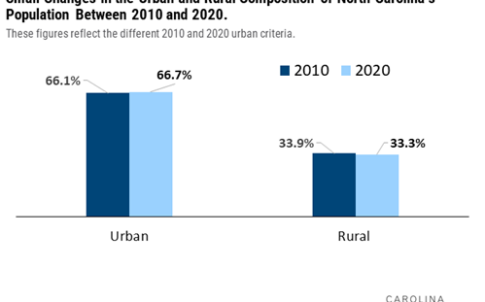How Does the New ‘Urban Area’ Definition Affect North Carolina?

In January, we posted a blog by Dr. Mike Cline, the NC State Demographer, “Making Sense of the New ‘Urban Area’ Definitions” in which he addressed the changes to how the Census Bureau defines urban areas. This post details the implications of the definition changes and the changing urban-rural composition of North Carolina’s population in general.
To recap, before 2020, the Census Bureau’s definition of urban was based solely on population density. An area was defined as urban if it had a minimum of 2,500 residents. Any area with less than 2,500 residents was classified as rural.
In 2020, the Census Bureau made three changes to how it defines urban:
In other words, to meet the new urban criteria, an area must have either 5,000 residents or 2,000 housing units. All other areas are classified as rural.

Table 1: Places in NC reclassified from urban to rural in 2020
Yes. 33 places in North Carolina (Table 1) were previously considered urban and reclassified as rural under the new criteria.

Figure 1 shows the North Carolina urban and rural population in 2010 and 2020. These figures reflect the 2010 and 2020 urban criteria, respectively.
The short answer is no. Figure 1 shows the North Carolina urban and rural population in 2010 and 2020. These figures reflect the 2010 and 2020 urban criteria, respectively. Using the different criteria, we can see in Figure 1. that the percent of the NC population residing in an urban area increased by 0.6% from 66.1% in 2010 to 66.7% in 2020. If we apply the 2020 urban criteria to the 2010 Census data (not shown here), the 2010 urban share of the state population drops to 65.0% resulting in an increase of 1.7% in the urban share of the population between 2010 and 2020.
Will these changes affect eligibility for federal aid for rural areas?
These changes will not likely affect eligibility for federal aid for rural areas. First, as mentioned above, these changes raised the population threshold for urban classification and led to more areas being classified as rural. Second, although the Census definition provides a baseline, different agencies use their own definitions of urban and rural, depending on specific program needs. A good example is the Health Resources & Services Administration (HRSA) which provides federal funding to rural health centers. You can read about how HRSA defines rural and how it is different from the Census Bureau here. You can check eligibility for Rural Health Grants using the Rural Health Grants Eligibility Analyzer.
Need help understanding population change and its impacts on your community or business? Carolina Demography offers demographic research tailored to your needs.
Contact us today for a free initial consultation.
Contact UsCategories: Uncategorized

The Center for Women’s Health Research (CWHR) at the University of North Carolina School of Medicine released the 12th edition of our North Carolina Women’s Health Report Card on May 9, 2022. This document is a progress report on the…

Dr. Krista Perreira is a health economist who studies disparities in health, education, and economic well-being. In collaboration with the Urban Institute, she recently co-led a study funded by the Kate B. Reynolds Foundation to study barriers to access to…

Our material helped the NC Local News Lab Fund better understand and then prioritize their funding to better serve existing and future grant recipients in North Carolina. The North Carolina Local News Lab Fund was established in 2017 to strengthen…
Your support is critical to our mission of measuring, understanding, and predicting population change and its impact. Donate to Carolina Demography today.